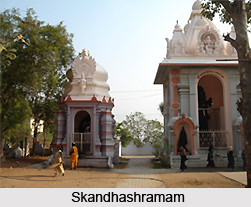 Skandhashramam temple was built by Shanthananda Swamigal. It is known for its Sahasra lingam which weighs 20 tons, 9 and a 1/2 feet in height which has 1007 lingams carved within and a Nandhi 5 ft long and 4 ft high.
Skandhashramam temple was built by Shanthananda Swamigal. It is known for its Sahasra lingam which weighs 20 tons, 9 and a 1/2 feet in height which has 1007 lingams carved within and a Nandhi 5 ft long and 4 ft high.
Other deities in the temple include Panchamukha Heramba Ganapathy, Kamala Siddhi Vinayakar, Bhuvaneshwari Amman, Panchamukha Aanjaneyar, Veera Sarabeswarar, Saniswarar, Swaminathaswamy (Skanda), Dattatreyar, Prathyankara Devi, Sri Chakra Maha Meru, Ayyapan, Ashtadasabhuja Durga Parameswari, Sudarshana Chakrathazhwar, Lakshmi Narasimhar.
The idol of Lord Ganesha on a lion vehicle is 12 feet high. It has five elephant heads, four faces facing the four directions and the 5th face facing the sky - upward. He holds in his ten arms the noose, goad, rudraksha garland, pownder, battle axe and cord. The architecture of the gopurams resemble the Orissa style of architecture
Kamala Siddhi Vinayagar stone idol is seen seated on a lotus with a flower, mango, sugarcane and parasu in his four arms and the kalasam in his trunk. This sannadhi is placed to the right of Goddess Bhuvaneswari and around this sannadhi are installed Yoga Ganapathy and Uchchista Ganapathy. Here the gopuram style is that of the Tamil Nadu type of architecture.
Goddess Bhuvaneshwari is the idol that is 6 ft. The two arms are in abhaya and varada postures. The noose and angusam are held in the upper arms. The idols of other Dasamahavidya deities Kali, Tara, Shodasi, Tripurabhairavi, Cinnamastha, Dhumavati, Bagalamuki, Rajamathangi, Kamalathmika are installed around the sannadhi. The Gopuram style is that of Tamil Nadu type of architecture
Sri Shantanada Swamigal idol is on the left of Goddess Bhuvaneswari. Sri Panchamukha Anjaneya stone idol is 14 ft high and is located at the vaayu moolai (north west corner) opposite Lord Saniswara. His five faces are the embodiment of Lord Anjaneya in the east, Lord Narasimha in the South, Garuda in the west, Varahaa in the North and Lord Hayagriva at the top.
Veera Sarabeswarar is a half bird half animal - with a lion face & wings. He was sent by Lord Shiva in order to control the wrath of Lord Narasimha after he had killed Hiranyakashipu. The two wings bear Goddess Prathiyankara and Goddess Soolini. In his arms he holds a deer, battle axe, snake and fire and Bhairava and Agni in his abdomen.
Lord Saniswarar is placed in the north east corner opposite Lord Panchamukha Hanuman. Since Lord Saniswara is facing Lord Hanuman it is believed that whoever is in the clutches of Sani will not face many problems. He is in the standing posture with one leg on his vehicle the crow while the other leg is placed on the ground. Different forms of Lord Saniswara are installed around the sannadhi. It resembles Orissa style of architecture.
Lord Swaminatha Swamy faces the Bhuvaneshwari sannadhi. There are several forms of Around this sannadhi are installed the different forms of Lord Muruga in the Arupadai veedu - Swamimalai, Tirutani, Tiruparankundram, Palani, Pazhamudircholai around this sannadhi.
Lord Dattatreya is installed in the south east corner opposite Panchamukha Heramba Ganapathy. Dattatreya is the son of sage Athri and Anusuya and is the embodiment of the Trinity - Lord Brahma, Lord Vishnu and Lord Shiva. He has 3 heads and 6 hands in which he holds a trident, rosary, lotus, discus, conch and a water-pot. Around this sannadhi Lord Brahma, Lord Vishnu and Lord Siva are installed. It resembles Orissa style of architecture.
Goddess Ugra Prathiyankara faces the Sannidhi of Lord Veera Sarabeswara. She is referred to as Aparajitha. It is believed that she emerged from the fire emanating from the third eye of Lord Sarabeswarar. Goddess Prathiyankara aided in subsiding the anger of Lord Narasimha. She has a lion face and is seated on a lion. Around this sannadi Navadurgas - Sri Sailaputri, Sri Brahmacharini, Chandrakande, Kushmande, Skandamatha, Kathayayini, Kalarathri, Mahagauri and Sidhithathri are installed.
Lord Ayyapa was the son of Lord Shiva and Lord Vishnu. He is in a sitting posture. His right hand shows the Gnana Mudra and his left hand shows the Vara Mudra. To his right the Kanni Moolai Ganapathy is installed. This gopuram is built in the Kerala type of architecture.
The idol of Sri Ashtadasabuja Durga Parameswari has 18 hands hold different weapons, including the trident of Lord Shiva, the discus of Lord Vishnu, the conch of Varuna, the bow and arrows of Vayu, the Vajra of Lord Indra. Lion is her vehicle. She stays in the Southern part, at the back of Sahasralingam in this temple facing the North side.
Sri Maha Sudarshana Murthy with Lakshmi Narasimhar is a panchaloka idol. Bhaktha Prahlada is in his right hand side standing and worshipping Sri Lakshmi Narasimhar. The images of the Dasavatharas are installed around this sannidhi.





















